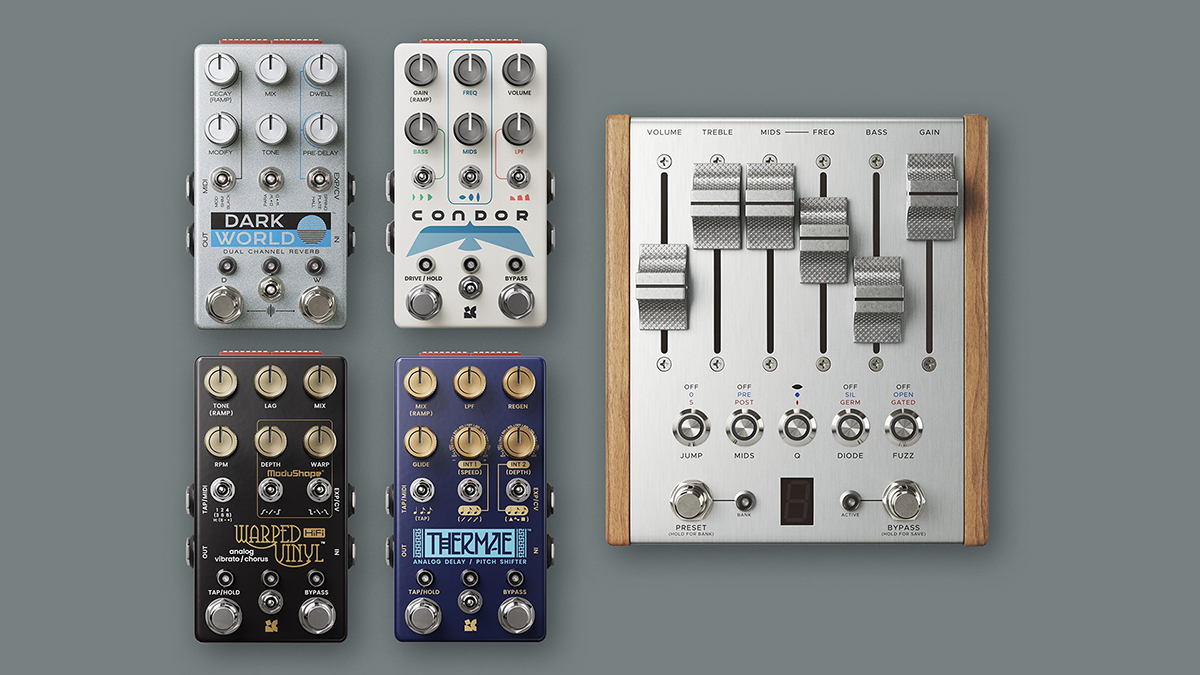“There’s so much we are working on, I'd rather keep my eyes forward. We’ll ultimately emerge stronger”: Why Chase Bliss has been forced to discontinue 5 of its finest pedals – and what it means for the firm's future

In late August, Chase Bliss introduced the Billy Strings Wombtone pedal – the effects specialist’s first-ever signature stompbox, which revived the cult classic phaser.
At the time, however, it was announced the Wombtone would be a US-exclusive limited-edition run, which would not be available overseas owing to the fact it contained certain Light-Dependent Resistors (LDRs).
LDRs – or vactrols, as they’re otherwise known – are a type of opto-isolator (“a component that transfers electronic signals between two isolated circuits by using light”), which are not UK or EU compliant.
Specifically, the Restriction of Hazardous Substances in Electronic and Equipment (RoHS) laws in these territories restrict the use of a particular component needed in these products.
The problem is, the Billy Strings signature Wombtone wasn’t the only Chase Bliss pedal to feature this component. Instead, it had previously been used in five of Chase Bliss’ finest effects pedals, which – after remaining stock runs out in the US – will now be discontinued.
In a blog post issued a few days before the release, Chase Bliss announced it would cease production on its Preamp MKII, Thermae, Dark World, Warped Vinyl HiFi and Condor HiFi.

It was a blow not only to the firm, but also to the wider pedal market. The slider-equipped Preamp MKII drive/fuzz/EQ, for example, was seen as a game-changer upon its release, and made its way onto a number of big-name pedalboards.
All the latest guitar news, interviews, lessons, reviews, deals and more, direct to your inbox!
It’s a similar case for the rest of the discontinued range – from the Condor overdrive and Thermae ‘analog timeshifter’ to the Dark World ‘dual space simulator – which helped affirm Chase Bliss’ reputation as one of the most forward-thinking pedal outlets currently around.
“The reason we are discontinuing these products is we have learned they are not compliant with market access requirements in the UK and the European Union,” Chase Bliss founder Joel Korte tells Guitar World.
“The way that opto-isolators work is, you have something that produces light – such as an LED or light bulb – that shines on a photoresistor in a dark environment. The photoresistor is a type of resistor that changes its resistance depending on how much light it sees.
“These photoresistors require cadmium sulfide (CdS) to work, and the RoHS laws restrict products that use components containing CdS.”

“As far as I can tell, these parts have been part of guitar pedal technology since as early as the 1960s in the form of the Univibe,” Korte explains. “There are many popular applications of this technology in audio now and in the past, including optical compressors, low-pass gates, channel switching in vintage amplifiers, optical tremolos, and optical phaser.”
Despite the historical and contemporary widespread use of vactrols in the audio industry, the reality is Chase Bliss will have to adjust to an immediate future without five of its most popular pedals. Not only that, it’s been required to slightly adjust its operations.




“In the near-term, this caused us to make our latest release region specific,” Korte goes on, referencing the Wombtone. “There are certain aspects of LDRs that are really special and useful in an audio context, especially in the digital control of analog technology.
“Some other methods exist for digitally controlling analog circuits like voltage-controlled amplifiers (VCAs) and digital potentiometers. Unfortunately, for certain functions there is no known replacement for LDRs.”
It’s not completely out of the question that the discontinued stompboxes could eventually be rebooted down the line sans vactrols. It would be a big ask, though.
“It's possible,” Korte responds when asked whether a return could be on the cards. “When we run out of stock of these pedals (only for sale in the USA), I'll monitor the market to see if there's a big demand for anything.
“If it's clear that our customers are asking for something, we'll definitely take note of that. It would be a big undertaking. though, and would require significant resources in redesigning the pedals from the ground up.”
Going forward, Korte is instead keen to continue innovating and expand Chase Bliss’ pedals range with new releases, and he doesn’t see this blip as too much of a setback. This has been greatly helped by the fact LDR usage in Chase Bliss production has naturally diminished over the years – so don’t expect similar discontinuations in the future.
“While LDRs have been a big part of my own design career, the rest of the engineering team has not utilized them like I have,” Korte notes. “Most of our more recent releases, as well as things we have in development, do not use LDRs. As I've transitioned to doing less engineering over the past few years, LDRs have played an increasingly smaller role in our company's R&D.
“On a personal level, I'd much rather start a new chapter and make something new than try to look backwards and redesign this stuff when I know it wouldn't be the same. We have so much we want to do and so much we are working on that I'd rather just keep my eyes forward.”
For Chase Bliss, the setback is just that: a setback, and one that won’t greatly disrupt the firm in the future by the sounds of things. So, expect the company to continue making its trademark brand of wild, wacky and boundary-pushing pedals.
That’s not to say the LDR issue won’t have more far-reaching ramifications for other effects firms, particularly those that operate in the UK and EU.
“We were contacted by a government agency in the UK. From what I can tell the brands that have been affected so far are UK-based, and us,” Korte continues. “The continued usage of this technology is fairly widespread in the industry from companies of all sizes from all over the world.”
Visit Chase Bliss to view its current crop of available effects pedals.

Matt is the GuitarWorld.com News Editor, and has been writing and editing for the site for five years. He has a Masters in the guitar, a degree in history, and has spent the last 19 years playing everything from blues and jazz to indie and pop. During his GW career, he’s interviewed Peter Frampton, Zakk Wylde, Tosin Abasi, Matteo Mancuso and more, and has profiled the CEOs of Guitar Center and Fender.
When he’s not combining his passion for writing and music during his day job, Matt performs with indie rock duo Esme Emerson, and has previously opened for the likes of Ed Sheeran, Keane, Japanese House and Good Neighbours.


